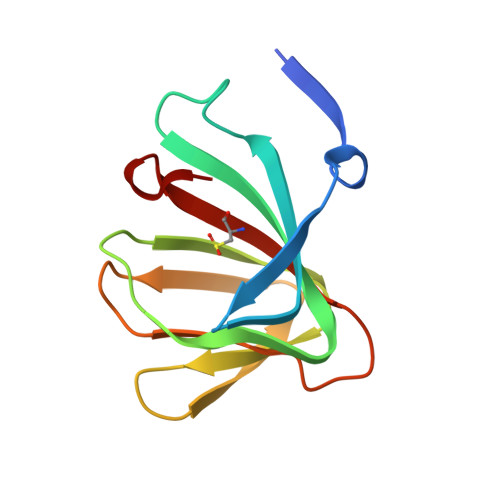A Well-Defined Osmium-Cupin Complex: Hyperstable Artificial Osmium Peroxygenase
Fujieda, N., Nakano, T., Taniguchi, Y., Ichihashi, H., Sugimoto, H., Morimoto, Y., Nishikawa, Y., Kurisu, G., Itoh, S.(2017) J Am Chem Soc
- PubMed: 28340294
- DOI: https://doi.org/10.1021/jacs.7b00675
- Primary Citation of Related Structures:
5WSD, 5WSE, 5WSF - PubMed Abstract:
Thermally stable TM1459 cupin superfamily protein from Thermotoga maritima was repurposed as an osmium (Os) peroxygenase by metal-substitution strategy employing the metal-binding promiscuity. This novel artificial metalloenzyme bears a datively bound Os ion supported by the 4-histidine motif. The well-defined Os center is responsible for not only the catalytic activity but also the thermodynamic stability of the protein folding, leading to the robust biocatalyst (T m ≈ 120 °C). The spectroscopic analysis and atomic resolution X-ray crystal structures of Os-bound TM1459 revealed two types of donor sets to Os center with octahedral coordination geometry. One includes trans-dioxide, OH, and mer-three histidine imidazoles (O 3 N 3 donor set), whereas another one has four histidine imidazoles plus OH and water molecule in a cis position (O 2 N 4 donor set). The Os-bound TM1459 having the latter donor set (O 2 N 4 donor set) was evaluated as a peroxygenase, which was able to catalyze cis-dihydroxylation of several alkenes efficiently. With the low catalyst loading (0.01% mol), up to 9100 turnover number was achieved for the dihydroxylation of 2-methoxy-6-vinyl-naphthalene (50 mM) using an equivalent of H 2 O 2 as oxidant at 70 °C for 12 h. When octene isomers were dihydroxylated in a preparative scale for 5 h (2% mol cat.), the terminal alkene octene isomers was converted to the corresponding diols in a higher yield as compared with the internal alkenes. The result indicates that the protein scaffold can control the regioselectivity by the steric hindrance. This protein scaffold enhances the efficiency of the reaction by suppressing disproportionation of H 2 O 2 on Os reaction center. Moreover, upon a simple site-directed mutagenesis, the catalytic activity was enhanced by about 3-fold, indicating that Os-TM1459 is evolvable nascent osmium peroxygenase.
Organizational Affiliation:
Department of Material and Life Science, Graduate School of Engineering, Osaka University , 2-1 Yamada-oka, Suita, Osaka 565-0871, Japan.
















